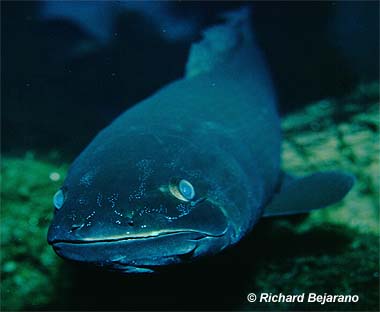
Amia calva
These freshwater fish are sometimes called ‘primitive’ because they display traits of fishs’ ancestors. They are able to breathe both air and water, putting them at an advantage in low-oxygen waters. The male bowfin guards the spawn for several months until they are able to forage on their own. Bowfin are long-lived predators so toxins (mercury, arsenic, chromium, etc) build up in their flesh at higher levels, and they are often not recommended for consumption.
Order: Amiiformes
Family: Amiidae
Genus: Amia
Species: calva
Common Names
English language common names are bowfin, beaverfish, blackfish, cottonfish, cypress trout, freshwater dogfish, grindle, grinnel, John A. Grindle, lawyer, marshfish, scaled ling, speckled cat, and western mudfish. Choupique is a common name used in Louisiana that was derived from the Choctaw name for bowfin. Other common names include alcaraz (Spanish), amerikanischer schlammfisch (German), amia (Danish/Finnish), amie (French), choupique (Creole/French), choupiquel (French), dyndfisk (Danish), il’naya ryba (Russian), kahlhecht (Russian), kaproun obecný (Czech), mieklawka a. amia (Polish), poisson de marais (French), poisson-castor (French), and schlammfisch (German).
Importance to Humans
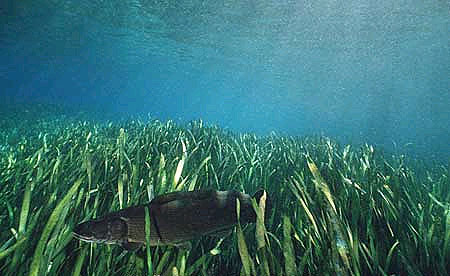
Since the bowfin feeds principally on fish it is frequently cursed for feeding on sportfish. They compete with the sport fish for food and may take any bait or lure that bass or catfish fishermen use. Bowfins are strong on the hook and are a game opponent for the angler.
The bowfin is commonly known as cottonfish in some parts, due to the fact that when they are improperly cooked or eaten cold, the flesh is said to ball up in one’s mouth like cotton. Food critics have given “Cajun caviar,” a delicacy made from the eggs of bowfin, rave reviews. Reviews regarding the flesh of the bowfin range from “soft and pasty” to “passably palatable, while being one of the best of all smoked fishes”.
The bowfin is commonly used as laboratory test animal because of its status as a “living fossil.” It is easy to maintain and has interesting behavioral and physiological temperaments. Young bowfin may be kept in an aquarium, however they may feed on smaller fish.
Conservation
> Check the status of the bowfin at the IUCN website.
At this time, the World Conservation Union (IUCN) does not consider the bowfin to be vulnerable or threatened. The IUCN is a global union of states, governmental agencies, and non-governmental organizations in a partnership that assesses the conservation status of species.
Geographical Distribution
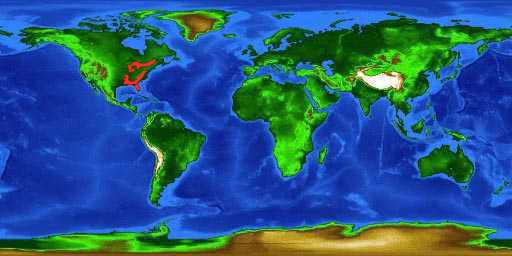
The bowfin has a distribution from St. Lawrence and Ottawa rivers and Lake Champlain west throughout the Great Lakes, including Georgian Bay and lakes in Nipissing and Simcoe, Ontario (Canada). They are found south in the Mississippi basin from Lake Winnibigoshish, Minnesota, to Louisiana, in the lower Texas drainages west to Colorado River and along Coastal Plain from Alabama to eastern Pennsylvania (US).
Changes in the environmental quality have probably all but eliminated the bowfin from the Missouri watershed system. It has been introduced in a number of localities in Iowa, Illinois, North Carolina, and Connecticut.
Habitat
Bowfins typically inhabit lowlands and are common in backwaters, oxbow lakes, and clear, well-vegetated streams. They have a preference for clear water with abundant vegetation but are tolerant of silt, mud, and high temperatures. Adult bowfins usually live in deep water, coming into shallows at night and during the breeding season.
Biology
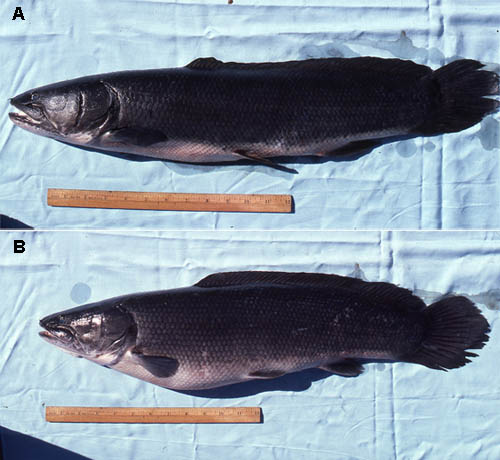
Distinctive Features
The bowfin fish is the sole bowfin belonging to the family Amiidae and the order Amiiformes. They have an elongate body with a dorsal fin running its entire length. The tail has semiheterocercal scales and the body is encased with cycloid scales. Its head is armored with a double skull and a large mouth and strongly developed teeth, bony gular plate, and tubular nostrils. Bowfins have kidney tubules opening directly into the coelomic cavity in contrast to other freshwater rayfin fish which have their kidneys closed off from the body cavity.
While many fish use their gas bladders for buoyancy, the bowfin can also use it to inhale air from the surface. At a temperature of 40ºF-50ºF (4.4ºC-10ºC), air breathing is non-existent, however at temperatures above 60ºF (10ºC) the rate of air breathing consistently increases as the temperature increases.
Air-breathing activity is greatest between 65ºF and 85ºF (18.4ºC and 29.6ºC). The air-breathing habit begins early in life, and when the school of young fish is undisturbed, individuals will occasionally leave the school and surface for a gulp of air. An example of the air-breathing activity may be seen in a floodplain of the lower Mississippi Valley, when farmers come across live bowfins with their plow after floodwaters had receded from farmland.
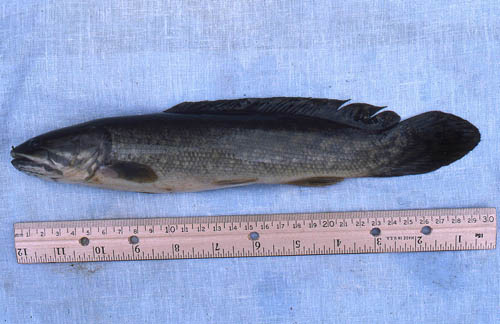
Coloration
The back and sides of the bowfin are olive-colored, with dark, and netlike mottling while the belly is cream-colored to white. The paired fins and anal fin are bright green. As juveniles both sexes have a round-to-oval black spot at the base of the upper caudal rays. Mature males have a black spot on the upper caudal rays rimmed with orange-yellow. Mature females do not have a black spot on the peduncle.
Dentition
The bowfin’s jaw contain strong, conical teeth.
Size, Age, and Growth
Adult bowfin females may reach 30 inches (75 cm), obtain a weight of 8½ pounds (3.8 kg) and, live approximately 12 years. Adult males may grow to attain a length of 18-24 in (457 – 610 mm) TL. The longest bowfin caught measured 34.3 in (870 mm) in length, while the largest bowfin fish caught in the United States (South Carolina) weighed 21 lbs. 8 oz. (9.8 kg). The largest bowfin fish caught in Florida waters weighed in at 19 lbs (8.6 kg).
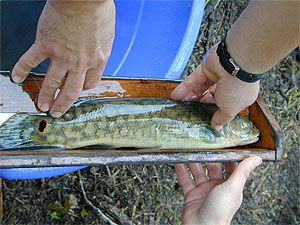
Food Habits
Bowfins normally eat fish, such as speckled perch and catfish in the northern region of Florida, but they may prey on freshwater crayfish.
Reproduction
Mating occurs between April and June in weedy shallow waters. Optimum temperature for nesting and spawning is 61ºF-66ºF, (16ºC-19ºC). The males arrive to the site first and construct nests in the form of a circular mat measuring 15-36 inches (39-91 cm) in diameter. As a female approaches a nest, the mating ritual begins with nose bites, nudges, and chasing behavior until the female is receptive. The female with lie on the nest while the male positions himself at her side and eggs are laid. Occasionally more than one couple will use the same nest and a male may try to mate with several females. After 8 to 10 days the eggs hatch. Upon hatching young are 8 mm long and attach themselves to rootlets by an adhesive organ until they are 9 days old and about 0.5 inches (12 mm) long. They then follow the male in a close school. If one become separated from the parent, it swims in close circles until its parent reappears. Adults have been known to take flight in order to protect their young from predators. They larvae feed on plankton and grow rapidly. When young reach a length of about 4 inches (102 mm), the schools start to break up. Young bowfins grow to over 8 inches (203 mm) in length during their first year of life.
Predators
The bowfin is not normally considered a sport fish but it commonly takes a hook and produces a worthy fight on light tackle. Since the adults are so well armored they probably have few natural enemies other than man.
Parasites
Anchor worms (Lernaea spp.) are large, external parasites that are commonly encountered by the bowfin. They normally attach themselves to the skin and bases of fins. Heavy infestations can slow the growth of a fish, cause it to lose weight, and even kill it.
The bowfin is also a host to the glochidia larvae of the mollusk Megalonaias gigantea. The eggs of the mollusk are fertilized internally by sperm entering with incurrent water flow. After fertilization, the eggs develop within the gill tubes into the tiny glochidia larvae.
Taxonomy
Linnaeus first described this species as Amia calva in 1766. Synonyms occurring in past scientific literature referring to this species include Amia ocellicauda Todd 1836, Amia occidentalis DeKay 1842, Amia cinerea Cuvier & Valenciennes 1846, Amia lentiginosa Cuvier & Valenciennes 1846, Amia lintiginosa Cuvier & Valenciennes 1846, Amia marmorataCuvier & Valenciennes 1846, Amia ornata Lesueur 1846, Amia reticulata Lesueur 1846, Amia subcaerulea Cuvier & Valenciennes 1846, Amia subcoerulea Valenciennes 1846, Amia viridis Lesueur 1846, Amia canina Valenciennes 1847, Amia ocellicaudata Fortin 1866, Amia piquotii Duméril, 1870, and Amia thompsoni Duméril, 1870.